From the October 2025 issue of Apollo. Preview and subscribe here.
Hew Locke can’t remember exactly when, on 7 June 2020, he first heard that the statue of Edward Colston in Bristol had been pulled off its plinth and thrown into the city’s harbour. While he thinks it may have been when the Art Newspaper asked him for comment, that also doesn’t seem right to him: ‘In my mind – memory plays tricks on you – that’s the story I tell myself.’ But now, he wonders, surely he heard the news on the radio first? What he is adamant about is that he was ‘stunned’.
When Black Lives Matter protestors deposed the late 19th-century statue of the 17th-century slave trader, Locke had more reason to be surprised than most. In Bristol, the continued presence of the statue in the heart of the city had been an issue for years, but it wasn’t a national or international debate and Colston’s name was not well known, except to historians of slavery or of Victorian civic sculpture. In 2006, however, the Bristol arts venue Spike Island had invited Locke to take part in the ‘British Art Show 6’. The four pieces in his Restoration series are large-format photographs of statues in the city – of Colston, Edmund Burke, the abolitionist Samuel Morley and Edward VII – mounted on to aluminium and MDF and then bedecked with gold medallions, jewellery and decorations attached to the surfaces. By turning a two-dimensional representation of an object into a different kind of third-dimensional representation, the works blur the boundaries between mediums, between photography and sculpture, in a way that is typical of Locke. The gaudiness of the trinkets are also a challenge to notions of propriety, of what is and isn’t said by public sculpture. At first glance, the decoration seems merely external – a festive get-up for sombre statues – but it is the opposite of a cover-up.
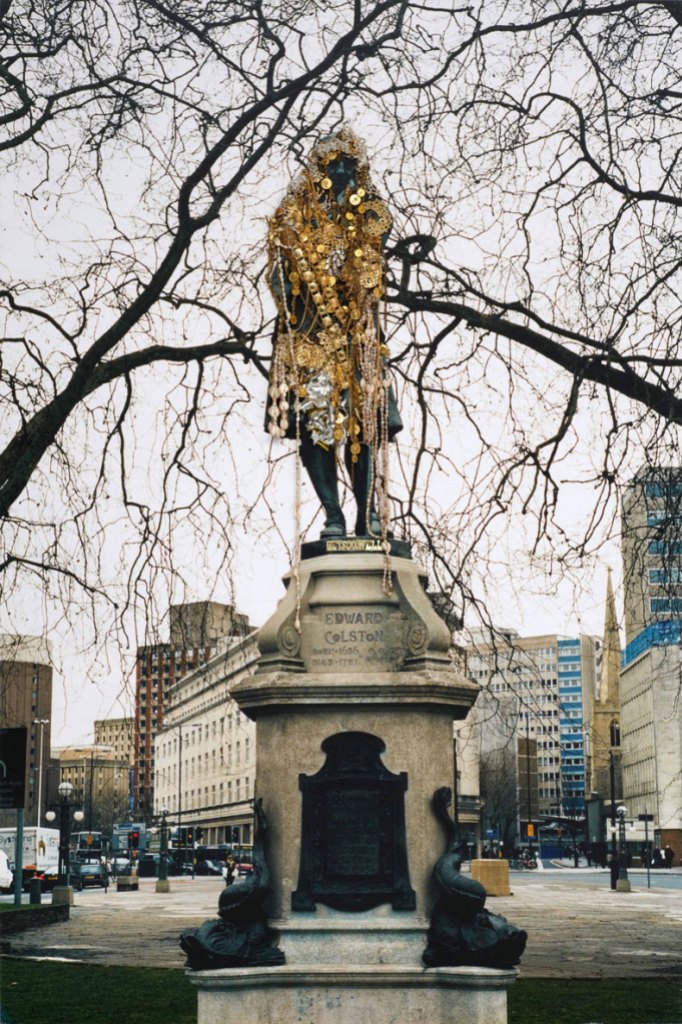
The statue of Colston was proposed and mostly paid for by a local Liberal, who wanted to celebrate his philanthropy in Bristol, skating over the fact that Colston’s fortune came from his shares in the Royal African Company, which had a monopoly for a time on the English slave trade in west Africa, transporting some 188,000 people to the Americas. In 2006, Locke’s dressing up of the statue was a thought experiment. In 2020, the protestors’ pulling it down was a rupture in reality that made the artist’s earlier work prescient. (If only, some commented, he had been allowed to festoon Colston for real, diminishing the figure by seeming to celebrate it, thus allowing it to stay where it was.)
All of this happened early on in the pandemic. Although exhibitions can be a long time in the making and public commissions particularly slow to achieve, to casual onlookers, it might seem as if Locke’s career to date falls into two phases: before and after the pandemic. In recent years, an extraordinary string of exhibitions and commissions have raised his profile and brought his work in front of a mass audience for the first time. In March 2022, a large-scale installation piece, The Procession, occupied the Duveen Galleries at Tate Britain until the following spring, while in the autumn, four sculptures by Locke filled the niches of the Met’s Fifth Avenue facade for the best part of eight months. Later that year, four equestrian Ambassador sculptures were a highlight of the ‘In the Black Fantastic’ group show at the Hayward Gallery in London. In 2024, an installation called Armada (2017–19) formed part of one of the most appealing rooms in ‘Entangled Pasts’, an exhibition at the Royal Academy of Arts in London looking at how the institution’s own history has shaped ideas about empire and migration. Also in 2024, in ‘Hew Locke: what have we here?’ at the British Museum, Locke and his wife, the curator Indra Khanna, were invited to present objects in its collection relating to Britain’s imperial history in Africa, India and the Caribbean, together with new works by Locke.
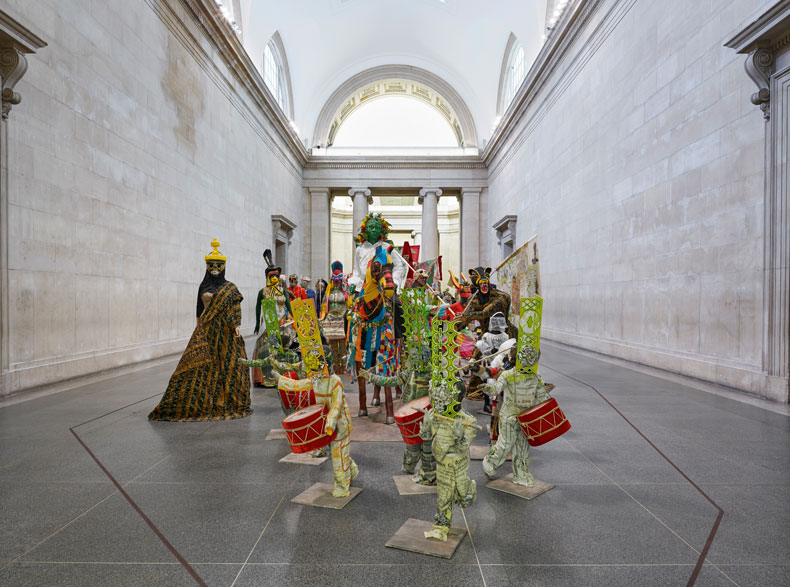
Locke is one of the most in-demand British artists working today, but the flurry of post-2022 activity obscures how consistent his interests have been, how they have widened and deepened over time and how the art world has caught up with his work – as events in the wider world have reflected his concerns – rather than the other way round. An exhibition opening at the Yale Center for British Art this month, ‘Hew Locke: Passages’, is a rare opportunity to see how Locke has become the artist he is (2 October–11 January 2026). By presenting three decades of his work in one place, it features work that hasn’t been seen for a long time, or at all – and, in Yale, a chance to see it free of the requirements of British institutions reflecting on their own histories. (British audiences should regret that the exhibition won’t travel, but the Yale monograph will be the most comprehensive account of Locke’s work for years to come.)
When I talk to Locke at the end of August, he seems more relaxed about the retrospective than any artist with as big a show coming up I have ever met. The reason, he says, is because after having made so much new work in recent years in the difficult conditions of the pandemic, at Yale, ‘It’s all historic work, so all I need to do is show up.’ He’s very clear, however, that he regards it as ‘a big deal’. Neither the Yale show nor any of his recent commissions would have seemed possible when he was a young art student, when ‘a career as somebody selling art was not something which was even considered’. His goal, when he started out in the 1980s, was ‘the standard goal for somebody my age back then […] to become a record album designer. Today that seems so bizarre, but that really was a goal.’
It may have seemed impossible to make a living by art but, for Locke, art has always been the family business. Both his parents were artists: his mother, Leila, an English figurative and landscape painter; his father, Donald, a Guyanese sculptor of largely abstract work that is only just getting its institutional dues (the first major Donald Locke survey show was at Spike Island, Bristol, earlier this year and is now at Ikon Gallery, Birmingham, until 22 February 2026). Hew was born in Edinburgh in 1959 and moved to Georgetown in Guyana with his mother and siblings when he was six, spending another six months in Edinburgh in 1969–70, before returning to the UK from Guyana in 1980. He went on to study fine art at the Falmouth School of Art and then, in the early ’90s, sculpture at the Royal College of Art.
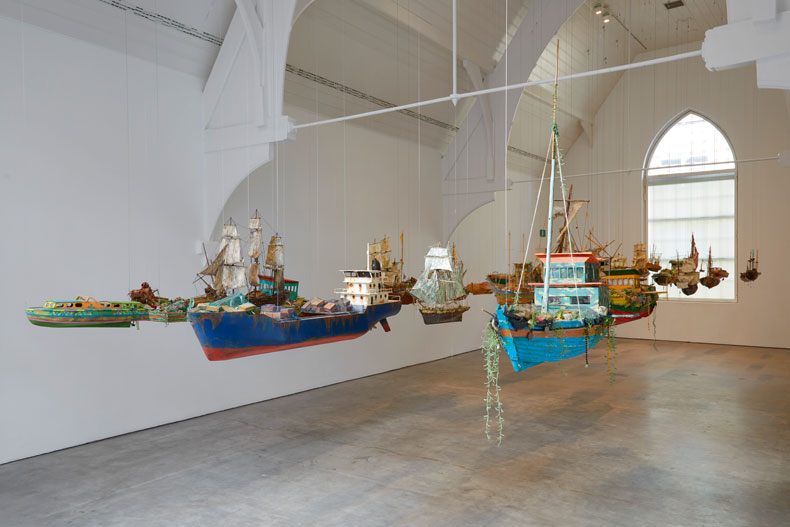
If Locke had gone to Goldsmiths, as he might have done, he would have been in the same year as the YBAs, he says, a group of artists whose work – as the popular caricature of it goes (flippant, cynical, ahistorical) – couldn’t have been more different than his. Nor could his own preoccupations, once he’d begun to work out what they were, have been less fashionable. It was residencies at the Delfina Foundation and then Gasworks in south London, where he had his studio for six years, that helped him refine his ideas and find new ways of making. For Locke, Gasworks, at a time when the art world was more insular, ‘was an international thing before international became a thing’. In his conversations with artists from all over the world, the real question, he says, was, ‘Where do we fit into this thing?’ (The ‘thing’ being ‘“Sensation”, Saatchi, stuff like that’.) Those conversations sustained him for years afterwards, as many as 15, he reckons, and meant that ‘I could be in the studio by myself because I’d worked out lots of ideas.
As Locke tells it, the ’90s was a time almost of hiding away. While he was aware of the wider art world – and admired much of the work that was attracting attention – he needed to find his own way: ‘My metaphor used to be: [I’m] in a forest, but there’s the Serengeti plains out there and there are lions waiting to take you down and I’m like, no, I’m going to stay here for a while until I feel strong enough to head out in the plains fast enough to be able to move in this situation.’
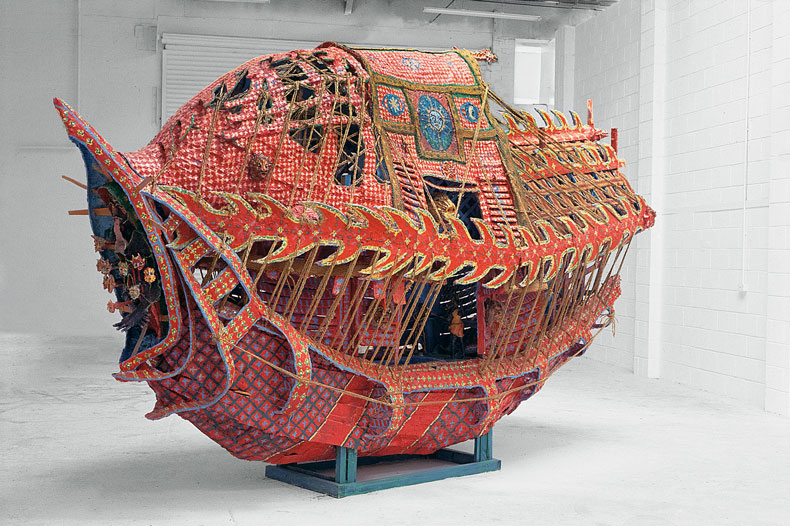
Locke’s first major work, Ark (1994), exhibited at his RCA graduation show, predates this period of germination and strength-training for the art-world savannah, but it was a remarkable statement of intent, inspired by sources that still inspire him, executed in unusual art materials – cardboard and papier mâché, even Locke’s work bench – and instantly pleasing to the eye. Ar is a boat with a puffer-fish profile, painted in a bright red and patterns Locke derived from Guyanese architecture or Indian miniature painting. Its immediate inspiration was an 18th-century model for an East India Company barge in Calcutta. It was well received, travelling to several UK venues but also, Locke felt – and this was true of his cardboard works from this decade – misunderstood as a work of folk art rather than sculpture, and conceptual sculpture at that. It was in the mid ’90s that Locke says that he stopped talking to people about Guyana to avoid questions about his work such as, ‘What carnival have you made this for?’
Describing something as ‘colourful’ or ‘vibrant’ can be a way of dismissing detail, of suggesting that an object or a work of art is not as serious as the sombre or monochrome kind. In a striking set of drawings made between 1996 and 1998, Locke seems to have worked through this problem by taking the subjects of European paintings and redoing them in charcoal and black and white pastels. The results are much harsher versions of, for example, the Infanta from Velázquez’s Las Meninas and Manet’s young fife player. They are harsher because they have been bleached of colour, yet at the same time more ornamented, every inch of their bodies and clothes covered in patterns of skulls, eyes and hands, among other motifs.
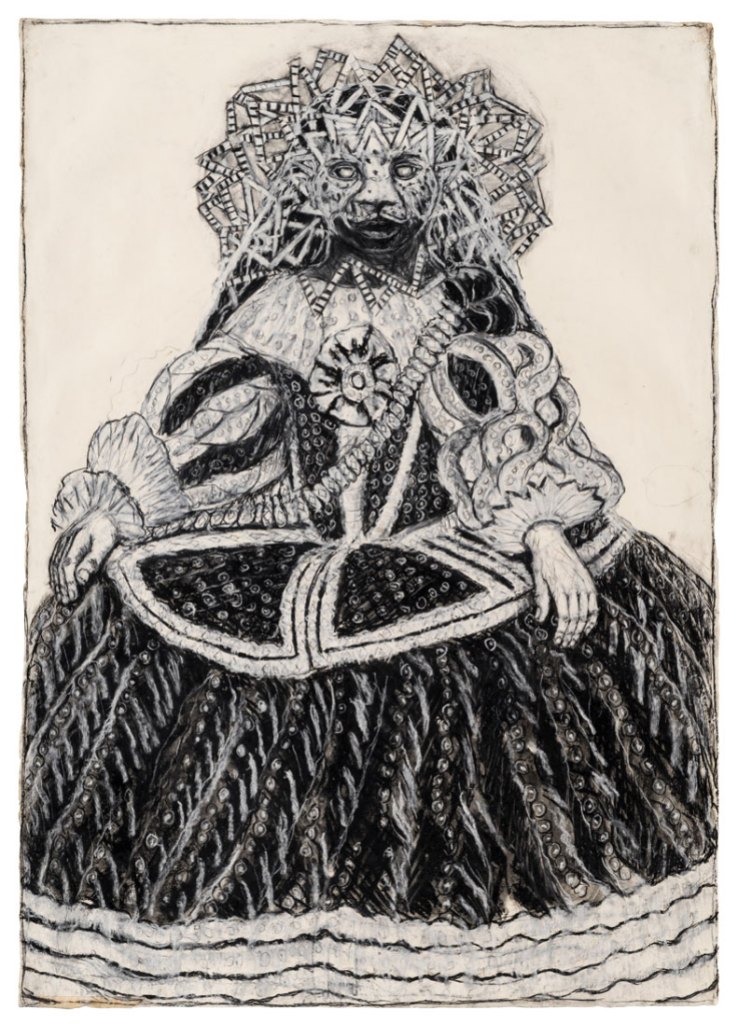
After this work of subtraction, it’s almost as if Locke felt ready to pile all his influences and interests – as well as the colour – back into his work, reconfigured and refined as the occasion required. That first sculpture, Ark, no longer exists, though. After the costs of storing it became too great, Locke had to let it be destroyed.
What has survived, however, is his enduring love of boats, which has expressed itself over the years in a series of installations, perhaps most memorably at the Folkestone Triennial in 2011. In a work called For Those in Peril on the Sea, Locke suspended 70 model boats in the vault of the ceiling of a parish church so that viewers could see only their hulls from below. In subsequent boat-based works with more attacking titles such as Armada, first installed at the Ikon Gallery in Birmingham, the models have been hung at a lower height, preventing the viewer from crossing the space they take up. In the UK, the words ‘small boats’ has, for some time, been a form of shorthand for asylum-seekers crossing the English Channel in the absence of less dangerous routes. When I ask Locke if the meaning of his small boats has changed over the years, he says he’s very conscious of the phrase. ‘I think of “small boats” as two different things. There are the small boats we talk about today, but then there are the small boats which went to get the troops from Dunkirk.’ And ‘armada’, he points out, is simply the Spanish name for a fleet; it’s the British, harking back to the failed invasion attempt of 1588, who have loaded the word with more negative connotations.
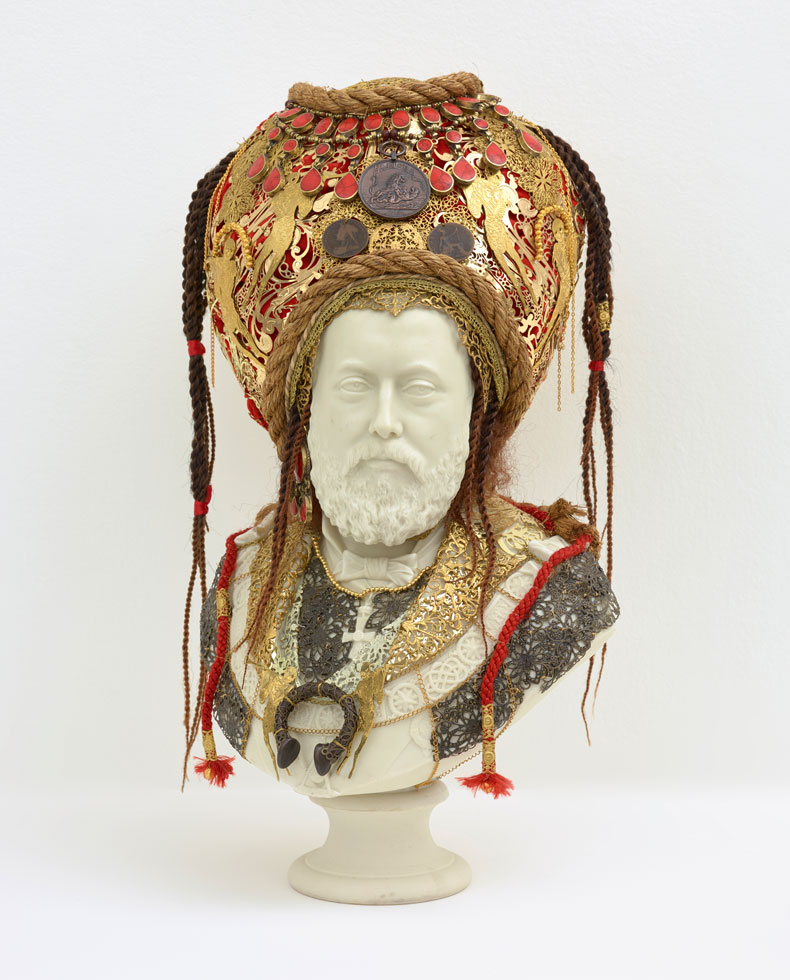
If the maritime works are among Locke’s most beautiful, it is his interest in the imagery of the British Empire and the visual manifestations of its power that hide in plain sight that have brought him to prominence. Perhaps Locke’s real achievement is to take signs of pomp and circumstance seriously, to reveal how surfaces can conceal. To make something plain is to be straightforward, to make your meaning clear. But the plain meaning of a monochrome statue or a bust tells us nothing except that the subject was once meant to be admired, and rarely for what reason. Locke’s Souvenir series (2018–ongoing) takes this idea to the point of absurdity by taking the busts of Victorian and Edwardian royals made of Parian ware (an unglazed porcelain that made for a cheap marble substitute) and covering them in baubles, replica medals and headpieces. Souvenir 8 (Edward VII in Masonic Regalia) from 2019 is a particularly attractive affair; with the sovereign’s medal- and jewellery-strewn headgear (which also sprouts dreadlocks) and splitting the difference between a crown and a turban, which seems appropriate for someone who was, after all, the Emperor of India.
In this and many other acts of decoration, Locke’s use of ornament is a useful, often witty act of complication, his art a playful challenge to monolithic ways of thinking. By asking objects where they have really come from, viewers might also come up with more interesting responses to the question Locke once asked himself and has answered more than successfully: ‘Where do we fit into this thing?’
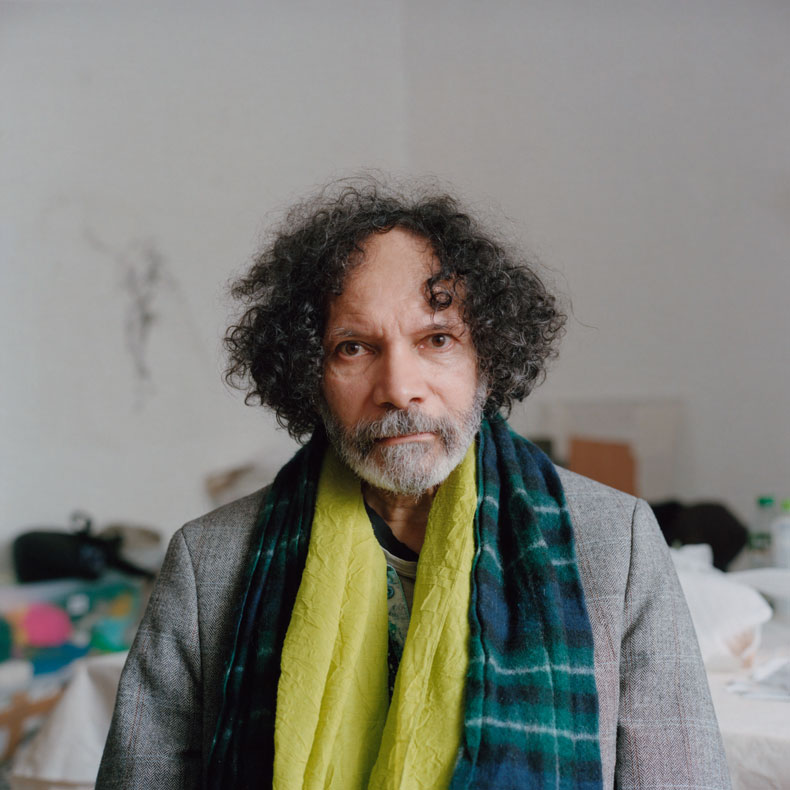
‘Hew Locke: Passages’ is at the Yale Center for British Art, New Haven, from 2 October–11 January 2026.
Portrait of Hew Locke: © Toby Glanville
From the October 2025 issue of Apollo. Preview and subscribe here.
